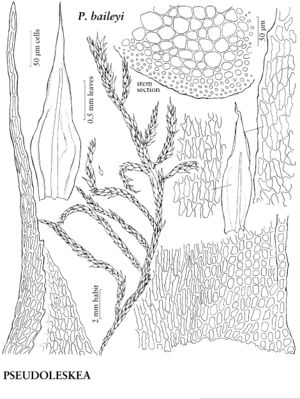Difference between revisions of "Pseudoleskea baileyi"
in A. J. Grout, N. Amer. Musci Pleuro p carpi, 474. 1917.
FNA>Volume Importer |
FNA>Volume Importer |
||
| Line 33: | Line 33: | ||
|elevation=low to moderate elevations (80-1400 m) | |elevation=low to moderate elevations (80-1400 m) | ||
|distribution=B.C.;Alaska;Oreg.;Wash. | |distribution=B.C.;Alaska;Oreg.;Wash. | ||
| − | |discussion=<p>Pseudoleskea baileyi is a distinctive endemic species, extending into the Aleutians, but does not belong in the genus (M. U. Krieger 2002). The combination of long acumen ending in a hair-point, elongate proximal laminal cells (to 60 µm), and lack of paraphyllia ally it with the eastern Asian Rigodiadelphus. However, the peristome is different from the peristome of that genus, which is strongly reduced and lacks segments and cilia. Pseudoleskea baileyi is locally common on bark of branches and twigs of trees and shrubs at moderately high elevations.</p> | + | |discussion=<p><i>Pseudoleskea baileyi</i> is a distinctive endemic species, extending into the Aleutians, but does not belong in the genus (M. U. Krieger 2002). The combination of long acumen ending in a hair-point, elongate proximal laminal cells (to 60 µm), and lack of paraphyllia ally it with the eastern Asian Rigodiadelphus. However, the peristome is different from the peristome of that genus, which is strongly reduced and lacks segments and cilia. <i>Pseudoleskea baileyi</i> is locally common on bark of branches and twigs of trees and shrubs at moderately high elevations.</p> |
|tables= | |tables= | ||
|references= | |references= | ||
| Line 57: | Line 57: | ||
|publication year=1917 | |publication year=1917 | ||
|special status=Endemic;Selected by author to be illustrated | |special status=Endemic;Selected by author to be illustrated | ||
| − | |source xml=https://jpend@bitbucket.org/aafc-mbb/fna-data-curation.git/src/ | + | |source xml=https://jpend@bitbucket.org/aafc-mbb/fna-data-curation.git/src/8f726806613d60c220dc4493de13607dd3150896/coarse_grained_fna_xml/V28/V28_555.xml |
|genus=Pseudoleskea | |genus=Pseudoleskea | ||
|species=Pseudoleskea baileyi | |species=Pseudoleskea baileyi | ||
Revision as of 17:06, 18 September 2019
Plants large, in thick, stiff mats, green, yellow-green, becoming orange-green, orange-brown, or brown with age. Stems with branches slender to robust, julaceous, apices curving up; central strand absent; paraphyllia absent. Leaves appressed when dry, erect-spreading when moist, dull, ovate-lanceolate, symmetric, strongly falcate-secund, 1.5–2.5 mm; margins recurved proximally; apex gradually acuminate, hair-point present; costa ending in acumen, not percurrent, green to yellow-green, not usually sinuate; alar cells quadrate to short-rectangular, region medium-sized; medial laminal cells elongate-rhomboidal, to 30 µm, 2–3:1, translucent, prorate, walls incrassate, somewhat pitted; juxtacostal cells longer, narrower than medial, walls pitted. Capsule erect to suberect, symmetric, 0.8–1.7 mm; operculum conic-apiculate; endostome basal membrane 1/3–1/2 exostome length, segments often longer than exostome teeth, cilia slender, 1 or 2, or often rudimentary to absent. Spores (14–)20–28 µm.
Phenology: Capsules mature spring–summer (May–Jul).
Habitat: Bark of branches and twigs of trees and shrubs, rock, soil
Elevation: low to moderate elevations (80-1400 m)
Distribution

B.C., Alaska, Oreg., Wash.
Discussion
Pseudoleskea baileyi is a distinctive endemic species, extending into the Aleutians, but does not belong in the genus (M. U. Krieger 2002). The combination of long acumen ending in a hair-point, elongate proximal laminal cells (to 60 µm), and lack of paraphyllia ally it with the eastern Asian Rigodiadelphus. However, the peristome is different from the peristome of that genus, which is strongly reduced and lacks segments and cilia. Pseudoleskea baileyi is locally common on bark of branches and twigs of trees and shrubs at moderately high elevations.
Selected References
None.
